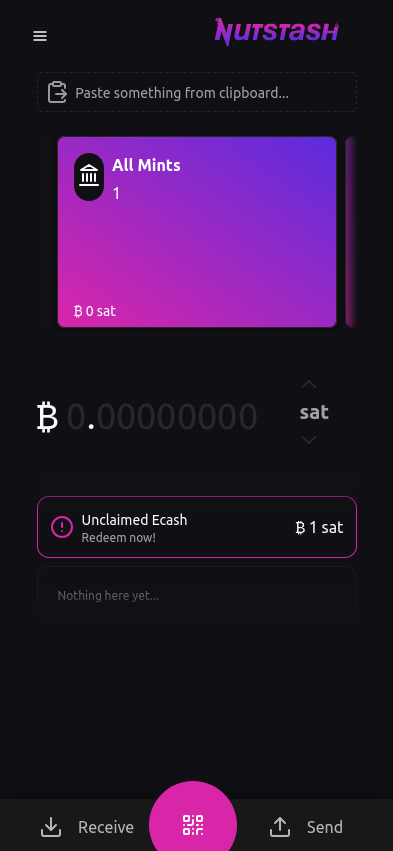-
 @ gandlaf21
2025-04-15 07:26:16
@ gandlaf21
2025-04-15 07:26:16Offline transactions with Cashu
Over the past few weeks, I've been busy implementing offline capabilities into nutstash. I think this is one of the key value propositions of ecash, beinga a bearer instrument that can be used without internet access.
 It does however come with limitations, which can lead to a bit of confusion. I hope this article will clear some of these questions up for you!
It does however come with limitations, which can lead to a bit of confusion. I hope this article will clear some of these questions up for you!What is ecash/Cashu?
Ecash is the first cryptocurrency ever invented. It was created by David Chaum in 1983. It uses a blind signature scheme, which allows users to prove ownership of a token without revealing a link to its origin. These tokens are what we call ecash. They are bearer instruments, meaning that anyone who possesses a copy of them, is considered the owner.
Cashu is an implementation of ecash, built to tightly interact with Bitcoin, more specifically the Bitcoin lightning network. In the Cashu ecosystem,
Mintsare the gateway to the lightning network. They provide the infrastructure to access the lightning network, pay invoices and receive payments. Instead of relying on a traditional ledger scheme like other custodians do, the mint issues ecash tokens, to represent the value held by the users.How do normal Cashu transactions work?
A Cashu transaction happens when the sender gives a copy of his ecash token to the receiver. This can happen by any means imaginable. You could send the token through email, messenger, or even by pidgeon. One of the common ways to transfer ecash is via QR code.
The transaction is however not finalized just yet! In order to make sure the sender cannot double-spend their copy of the token, the receiver must do what we call a
swap. A swap is essentially exchanging an ecash token for a new one at the mint, invalidating the old token in the process. This ensures that the sender can no longer use the same token to spend elsewhere, and the value has been transferred to the receiver.
What about offline transactions?
Sending offline
Sending offline is very simple. The ecash tokens are stored on your device. Thus, no internet connection is required to access them. You can litteraly just take them, and give them to someone. The most convenient way is usually through a local transmission protocol, like NFC, QR code, Bluetooth, etc.
The one thing to consider when sending offline is that ecash tokens come in form of "coins" or "notes". The technical term we use in Cashu is
Proof. It "proofs" to the mint that you own a certain amount of value. Since these proofs have a fixed value attached to them, much like UTXOs in Bitcoin do, you would need proofs with a value that matches what you want to send. You can mix and match multiple proofs together to create a token that matches the amount you want to send. But, if you don't have proofs that match the amount, you would need to go online and swap for the needed proofs at the mint.Another limitation is, that you cannot create custom proofs offline. For example, if you would want to lock the ecash to a certain pubkey, or add a timelock to the proof, you would need to go online and create a new custom proof at the mint.
Receiving offline
You might think: well, if I trust the sender, I don't need to be swapping the token right away!
You're absolutely correct. If you trust the sender, you can simply accept their ecash token without needing to swap it immediately.
This is already really useful, since it gives you a way to receive a payment from a friend or close aquaintance without having to worry about connectivity. It's almost just like physical cash!
It does however not work if the sender is untrusted. We have to use a different scheme to be able to receive payments from someone we don't trust.
Receiving offline from an untrusted sender
To be able to receive payments from an untrusted sender, we need the sender to create a custom proof for us. As we've seen before, this requires the sender to go online.
The sender needs to create a token that has the following properties, so that the receciver can verify it offline:
- It must be locked to ONLY the receiver's public key
- It must include an
offline signature proof(DLEQ proof) - If it contains a timelock & refund clause, it must be set to a time in the future that is acceptable for the receiver
- It cannot contain duplicate proofs (double-spend)
- It cannot contain proofs that the receiver has already received before (double-spend)

If all of these conditions are met, then the receiver can verify the proof offline and accept the payment. This allows us to receive payments from anyone, even if we don't trust them.
At first glance, this scheme seems kinda useless. It requires the sender to go online, which defeats the purpose of having an offline payment system.
I beleive there are a couple of ways this scheme might be useful nonetheless:
-
Offline vending machines: Imagine you have an offline vending machine that accepts payments from anyone. The vending machine could use this scheme to verify payments without needing to go online itself. We can assume that the sender is able to go online and create a valid token, but the receiver doesn't need to be online to verify it.
-
Offline marketplaces: Imagine you have an offline marketplace where buyers and sellers can trade goods and services. Before going to the marketplace the sender already knows where he will be spending the money. The sender could create a valid token before going to the marketplace, using the merchants public key as a lock, and adding a refund clause to redeem any unspent ecash after it expires. In this case, neither the sender nor the receiver needs to go online to complete the transaction.
How to use this
Pretty much all cashu wallets allow you to send tokens offline. This is because all that the wallet needs to do is to look if it can create the desired amount from the proofs stored locally. If yes, it will automatically create the token offline.
Receiving offline tokens is currently only supported by nutstash (experimental).
To create an offline receivable token, the sender needs to lock it to the receiver's public key. Currently there is no refund clause! So be careful that you don't get accidentally locked out of your funds!

The receiver can then inspect the token and decide if it is safe to accept without a swap. If all checks are green, they can accept the token offline without trusting the sender.

The receiver will see the unswapped tokens on the wallet homescreen. They will need to manually swap them later when they are online again.
 Later when the receiver is online again, they can swap the token for a fresh one.
Later when the receiver is online again, they can swap the token for a fresh one.
Summary
We learned that offline transactions are possible with ecash, but there are some limitations. It either requires trusting the sender, or relying on either the sender or receiver to be online to verify the tokens, or create tokens that can be verified offline by the receiver.
I hope this short article was helpful in understanding how ecash works and its potential for offline transactions.
Cheers,
Gandlaf